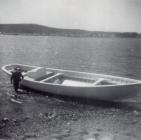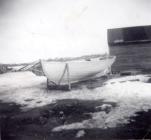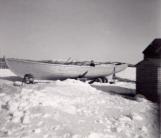1
Four trapskiffs built by Herbert and Clarence Genge1968
Genges' Sawmill, Glovertown, Newfoundland & Labrador, Canada
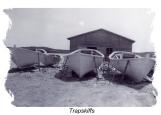
2
According to the 'Dictionary of Newfoundland English' a trapskiff is a "large undecked fishing boat, propelled by oar, small sail or engine and used in the coastal fishery to set and haul nets, especially cod traps."Trapskiffs were a fundamental part of the inshore fishery. Fishermen from Central Bonavista Bay used them extensively in the 1950s, 1960s and 1970s. The large demand for these boats kept boat builders busy building from dawn to dusk.
Trapskiffs range from twenty-four to thirty-four feet in length. They are designed such that when hauling traps they lie on their side, almost touching the waters edge while being loaded. The hauling was all done by hand because there were no mechanical haulers then.
Fiberglass speedboats and outboard motors used with trawls and gill nets eventually replaced the trapskiff. Long liners took over from there.
3
Trapskiff built by Herbert and Clarence Genge1979
Genges' Sawmill, Glovertown, Newfoundland & Labrador, Canada
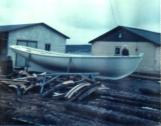
4
Herbert and his brother Clarence owned and operated 'C & B Genge Boatbuilders.'They built close to one hundred boats. This trapskiff is only one of many trapskiffs built by the Genge brothers. They learned to build boats from their father and picked some of the skill up on their own.
Ordinary carpenters' tools were used to build their boats: circular saws, band saws, jointers and heavy saws. Heavy saws were used to saw round timber into lumber.
The brothers cut all of their own timber. Paint, nails and oakum were their only expenses. Many long hours and much hard work were required to make their living.
Notice the curved timber in the forefront of this picture - part of the preparations for the next trapskiff to be built by the Genges.
5
Framed trapskiff built by Herbert and Clarence Genge1968
Genges' Sawmill, Glovertown, Newfoundland & Labrador, Canada
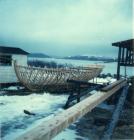
6
"This trapskiff is up in frame, ready to take plank." (Herbert Genge) The frame of a trapskiff comes from crooked timber: builders spend many hours in the woods looking for ideal trees. The timber is then cut into lumber. When placed in the boat, this timber forms the frame. In contrast most speedboat frames are steamed and bent to the right curve.Two men equipped in the summer (long days) could build a trapskiff in one month.
According to Mr. Herbert Genge, trapskiffs and motorboats are the same except trapskiffs are used for fishing and must be open-decked whereas motorboats are for pleasure mainly and can be open-decked or have a cabin.
7
Four trapskiffs built by Herbert and Clarence Genge1968
Genges' Sawmill, Glovertown, Newfoundland & Labrador, Canada

8
The Genge brothers built trapskiffs for the government on two occasions. The first time was in the late 1950s for 'Labrador Indian Affairs.' Once the boats were completed, they were shipped to Wesleyville where they were picked up by the coastal boat and delivered to Labrador. 'Labrador Indian Affairs' paid the Genge brothers $600 per boat.The second time was during the late 1970s for the 'Fishery Loan Board.' Anyone wanting a trapskiff built applied to the government and the government would contact builders for specific boats. 'The Fishery Loan Board' paid the Genges $7000 - $8000 for each boat. On both occasions an extra $10/foot for the length of each boat was also paid to honor the government bounty rule.
Engines weren't included in the price of the boat. Sometimes the brothers were in direct contact with the people who wanted the boat built. If someone wanted an engine, the brothers added the price of it to the bill for the government. The individual they were building the boat for picked out the motor desired. Others sent motors to the Genges to be installed.
The boats had to be built according to government specifications. All of the boats were inspected by provincial inspectors and sometimes federal inspectors. Mr. Duke Manuel of Glovertown, Inspector for 'Department of Fisheries and Oceans,' inspected the trapskiffs the Genges built for the 'Fishery Loan Board.'
There was abuse of these government grants. Some people did not take care of their boats and motors because they knew the government would replace them the following year.
9
Here follows several trapskiffs built by Captain Ken Saunders. Captain Saunders cut the timber used in the construction of these boats. It almost always took two or three months in the winter to build a trapskiff: January, February and March. However, the last trapskiff he built was completed in six weeks.Captain Saunders built boats for the 'Labrador Indian Affairs' as well. He built trapskiffs (twenty-nine to thirty feet in length) and punts (eighteen feet in length). During the fall the Labrador fishermen would place their boat order with the 'Labrador Indian Affairs' who in turn contacted Captain Saunders with the specifications of the order. In the spring a schooner picked up the boats and delivered them along the Labrador coast.
Captain Saunders also built trapskiffs for his own use. Along with his crew, he would leave for the Labrador fishery with one trapskiff in tow and the other aboard his schooner. When they reached their destination they anchored the schooner. The crew of about ten people would get aboard the two trapskiffs to fish. They hauled their cod nets, filled their boat to capacity, then returned to the schooner to unload.
10
Captain Ken Saunders standing by his thirty foot trapskiff1965
Glovertown, Newfoundland & Labrador, Canada
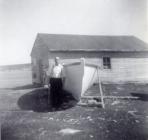
13
Trapskiff built by Captain Ken Saunders1961
Alexander Bay, Glovertown, Newfoundland & Labrador, Canada
